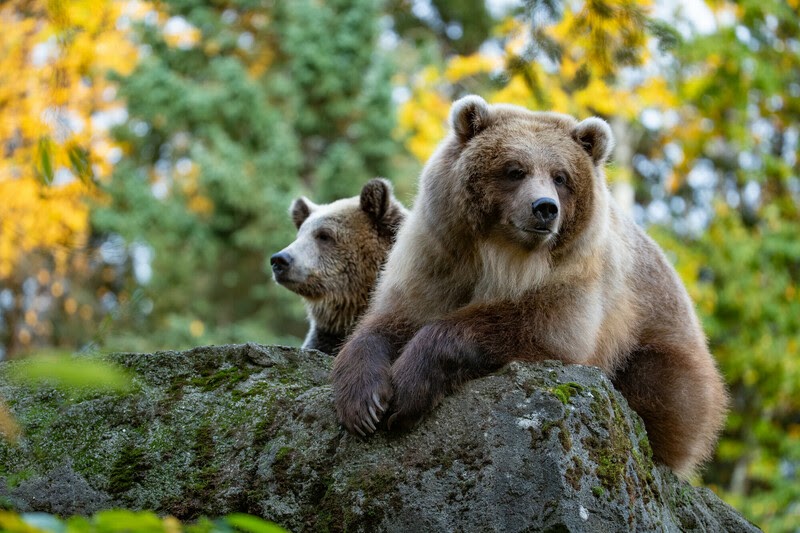Summary of Juniper and Fern—Catch Up With These Beary Best Buds:
Hattie Potter, writing for the Woodland Park Zoo, updates us on Juniper and Fern, two young brown bears that have become fast friends at the zoo. The article, supported by Jeremy Dwyer-Lindgren’s photography, shares insights into the bears’ lives and development. Born in January 2022, Fern, a grizzly from Montana, and Juniper, a coastal brown bear from Anchorage, Alaska, were rescued and brought to the zoo, where they’ve been thriving thanks to advanced animal care practices. The bears, now two years old, enjoy a varied diet but love nuts, meat, grapes, fruit, and honey. Distinct physical features and preferences set them apart, with Fern being a darker, deep-thinking bear and Juniper being larger with a playful demeanor. The bears share a strong bond, spending their time swimming, playing, and resting together. Woodland Park Zoo encourages public involvement in bear conservation through proper food storage, safe hiking practices, and educational initiatives like the Living Northwest Trail, aiming to foster coexistence between humans and wildlife. The zoo also highlights the importance of consistent support for wildlife conservation efforts.
– Insights into the lives of Juniper and Fern, the brown bear besties at Woodland Park Zoo
– The role of zoos in wildlife conservation and education
– How animal care teams at zoos work to provide naturalistic habitats and enrichment for animals
– Steps the public can take to contribute to the protection of brown bears in the wild
– The impact of conservation programs on native wildlife populations
Juniper and Fern, the dynamic duo of brown bears at Woodland Park Zoo, have captured the hearts of visitors and online followers alike. Behind their playful antics and companionable moments lies a story of rescue, rehabilitation, and the broader role of modern zoos in wildlife conservation. This article explores the intricate care provided to these bears, delves into the significance of zoos in education and conservation efforts, and outlines how everyone can contribute to the well-being of brown bears globally.
**Juniper and Fern: A Glimpse into Their World**
Born in the wilds of Montana and Alaska, Juniper and Fern were found in vulnerable situations without their mothers. Their stories took a hopeful turn when they were rescued and brought to Woodland Park Zoo, where they have since thrived. Now, at two years old, they are symbols of successful rescue operations and ambassadors for their species, shedding light on the plight of brown bears in the wild.
Observing Juniper and Fern, it’s evident that the zoo’s animal care team has gone to great lengths to mimic the bears’ natural habitat. Their enclosure features a pool for swimming, caves for hiding, and ample space for running and play-fighting. Such enrichments are vital, as they stimulate the bears mentally and physically, closely mirroring the challenges they would face in the wild.
**The Role of Zoos in Wildlife Conservation and Education**
Historically, zoos served as menageries that displayed exotic animals for public amusement. However, today’s accredited zoos have shifted their focus towards conservation science, education, and wildlife preservation. By housing species like Juniper and Fern, zoos play a critical role in educating the public about wildlife conservation, inspiring visitors to appreciate and protect these magnificent creatures in their natural habitats.
Zoos also participate in global conservation efforts and breeding programs to bolster endangered species populations. Through such initiatives, zoos contribute directly to the survival of species that might otherwise face extinction.
**Animal Care and Habitat Enrichment**
Dedicated zookeepers and animal care teams are central to the well-being of zoo inhabitants like Juniper and Fern. Daily routines include preparing specialized diets, creating engaging enrichment activities, and conducting health checks. This comprehensive care mirrors the animals’ natural behaviors, encouraging foraging, problem-solving, and social interactions that they would experience in the wild.
Environments are meticulously designed to replicate native habitats, with vegetation, substrates, and water features that reflect the animals’ ecological needs. Such attention to habitat detail is crucial for the animal’s physical health and psychological well-being.
**Public Contribution to Wildlife Conservation**
Individuals can help safeguard brown bears and other wildlife by adopting responsible behaviors, especially when in or near natural habitats. Proper food storage while camping, respecting wildlife by maintaining a safe distance, and supporting conservation efforts through donations to reputable organizations are concrete steps anyone can take.
Moreover, educating oneself and others about brown bears’ challenges, including habitat loss and conflict with humans, contributes to a more informed and engaged public ready to support conservation initiatives.
**Conservation Programs’ Impact**
Programs like Woodland Park Zoo’s Living Northwest conservation effort demonstrate the positive outcomes possible when zoos, researchers, and the public collaborate. By focusing on the recovery of native species and ecosystem resilience, these programs ensure species’ long-term survival, providing a beacon of hope for conservation worldwide.
Through initiatives like reintroducing species to their native habitats, zoos improve biodiversity and restore ecological balance, highlighting the interconnectedness of all living beings.
In the broader narrative of wildlife conservation, Juniper and Fern’s story underscores the potential of focused efforts to make a difference. With their dual mission of education and conservation, Zoos serve as vital links between humans and the natural world, reminding us of our responsibility to protect and preserve it for future generations. Through understanding and actively participating in conservation efforts, individuals contribute to the ongoing story of species like Juniper and Fern, ensuring that brown bears and other wildlife thrive in zoos and the wild.


